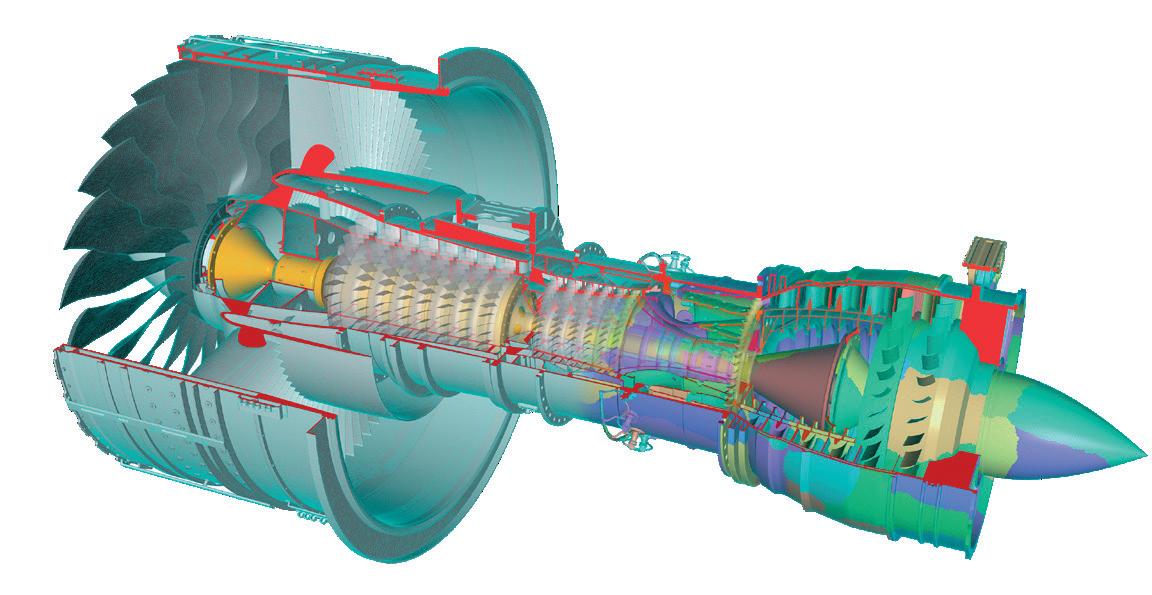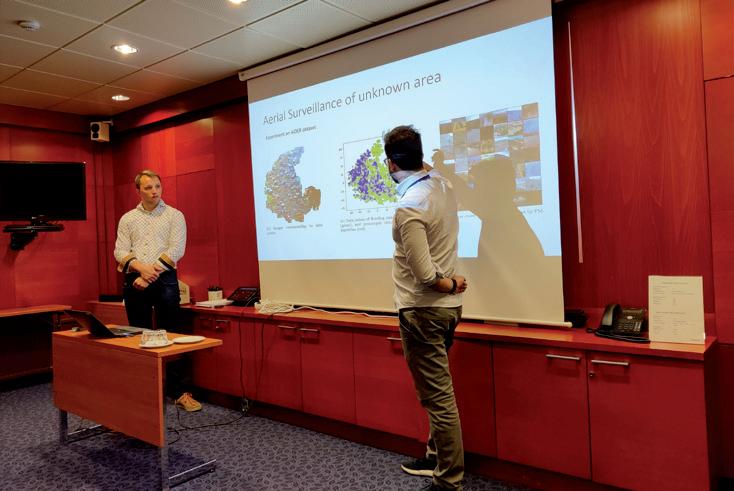
13 minute read
HiPEAC futures
from HiPEACinfo 66
by HiPEAC
The HiPEAC Student Challenge showcases projects by computer science and engineering students, whether undergraduate, master’s or PhD. With a theme of the internet of things (IoT) for everyone, the latest edition, at Computing Systems Week Tampere, featured projects ranging from disaster responses to traffic-sign management, as shown in this article.
Students storm the IoT in Tampere
Advertisement
A real-time UAV surveillance system for natural disaster management
TEAM: Daniel Hernández, José D. Padrón, Kiyoshy Nakamura and Jamie Wubben, advised by José M. Cecilia and Carlos T. Calafate, Universitat Politècnica de València
Natural disasters cause devastating loss of life and massive economic losses, and, according to the Red Cross and Red Crescent societies, have increased by 35% since the 1990s. In response, a team from the Universitat Politènica de València came up with an unmanned aerial vehicle (UAV) solution allowing real-time monitoring of natural disasters using artificial intelligence (AI) techniques. The aim was to automate the process of image and video interpretation that will reduce or avoid possible losses, provide the necessary attention to the victims, or speed up decision making during this type of event.
The team proposed a framework comprising a digital twin and a set of UAVs, equipped with a powerful but lightweight computer, such as the NVIDIA Jetson Nano. The UAVs provide the digital twins with real-time data of the natural disaster. In addition, edge machine-learning techniques help analyse images provided by the UAVs and hence optimize decision making under pressure. As such, the project integrates the coordination of drone swarms for visual information gathering and computer vision at the edge into a proof of concept.
Traffic-sign recognition IoT-based application
TEAM: Narges Mehran, Dragi Kimovski, Zahra Najafabadi Samani, Radu Prodan, Alpen-Adria-Universitaet Klagenfurt
This project involved the design of a trafficmanagement application to respond to road-safety concerns. The application receives a raw video, encodes it with a video CoDec in high resolution, divides it into frames and detects the traffic sign shown in the video using a multiclass machine-learning model. The end user – either a vehicle driver or passenger – then receives a warning related to the traffic sign.
The application, along with its source code, can be downloaded from the team’s GitHub repository: github.com/SiNa88/ Traffic-sign-recognition-application
Analysis and processing of digital health data using the IoT and multiple analytical techniques
RESEARCHER: Adite Site, supervised by Jari Nurmi and Elena Simona Lohan, Tampere University
New technologies such as mobile apps, novel sensors and wearables are creating a major new source of healthcare data. In addition, they allow patients and healthcare professionals to store, process and share medical data for the coordination of care. However, continuous sensor data from wearables is voluminous, varied and unstructured, and needs to be analysed to offer meaningful insights. Lack of uniformity, consistent standards and interoperability also pose a problem for generating and adopting a common analytical platform for better management and delivery of healthcare services.
Using digital health data, machine learning algorithms and IoT, this research project aims to determine how digital health data can be used for connected healthcare systems to enable remote monitoring and report critical events. It also aims to explore how heterogeneous healthcare data can be combined, processed and analysed using machine learning algorithms.
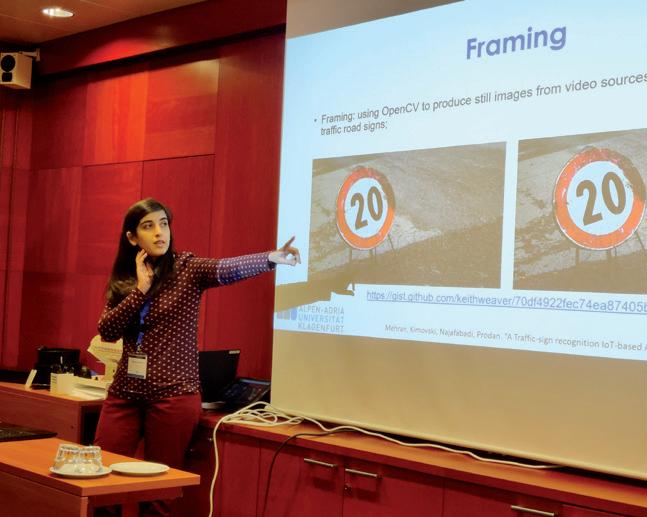
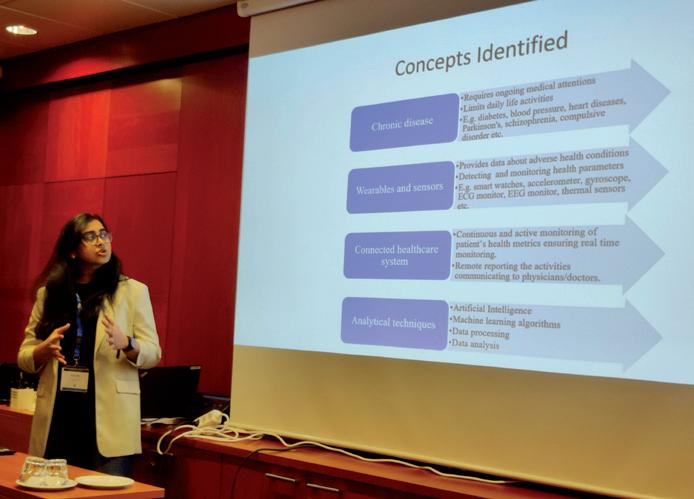
Finding your ideal career path with HiPEAC Jobs
Deciding on a career path is not always easy, but HiPEAC Jobs is here to help. With careers sessions from roundtables to STEM student days, explore your options and hear from all different kinds of professional. Who knows, your dream job might be one you haven’t even heard of yet?
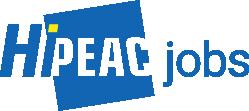
As a community of over 2,000 computing systems specialists, with a well-established calendar of networking events, HiPEAC offers the ideal environment for researchers to build fulfilling careers, whether in academia or industry. Since HiPEAC was established in 2004, numerous cohorts of researchers have progressed from the beginning of their PhDs to postdoc and senior positions. Along the way, they may have participated in the HiPEAC Student Challenge, attended the ACACES summer school, done an internship or received a collaboration grant for a research visit, presented a poster or discussed a project proposal at the HiPEAC conference and subsequently worked on a project during a Computing Systems Week.
For some time, HiPEAC has been leveraging the robust experience base of our community to organize dedicated careers sessions during HiPEAC events. Many HiPEAC members are generously willing to share what they have learned with the next generation of computer scientists and engineers, while for others participating in a careers event is a welcome opportunity to scout for talent.
Careers sessions may include presentations, a roundtable discussion, and / or a tour of company booths, for example. The main objectives of the sessions are as follows: • to provide or receive inspirational insights into different career paths • to give or get advice on career development • to share or learn the main skills employers look for • to present or hear about potential vacancies or internships, as well as related projects, training networks and programmes • to discuss and discover the best strategies for talent attraction, on the employer side, or for impressing your interviewer, on the employee side
There’s a special chemistry at HiPEAC events, thanks to the blend of technical specialists, students and business developers, and this is obvious in the careers sessions. Topics that have been explored include the value of studying for a PhD, as a door to other opportunities, or the differences between working at a research centre, a university, a major multinational company, a small business, or even your own startup. Students are invited to think out of the box and have their preconceptions challenged, while in general the sessions seek to help them answer the question: ‘Why am I doing what I am doing?’
FURTHER INFORMATION:
Find out about forthcoming careers activities on the HiPEAC Jobs career centre webpage bit.ly/HiPEACJobs_career_centre
Check out presentations from former events, interviews with experts and more on HiPEAC TV https://bit.ly/HiPEACJobs_YT_playlist
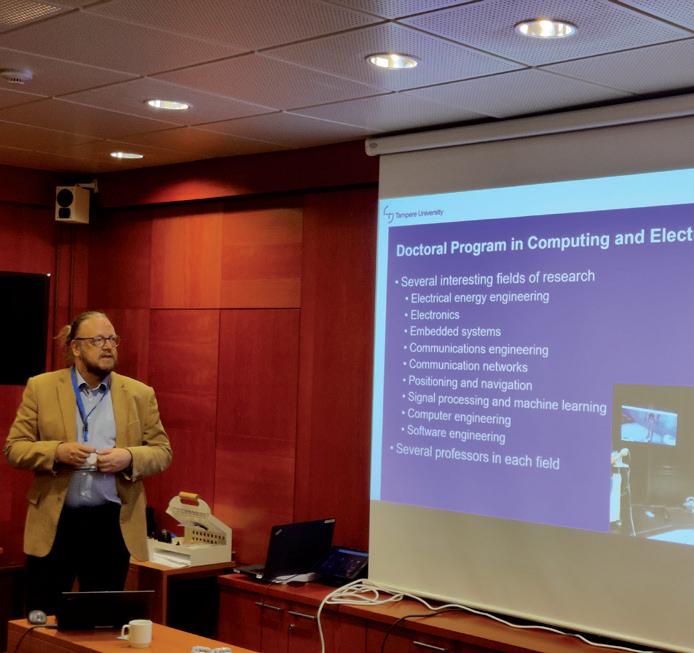
HiPEAC careers events take different formats
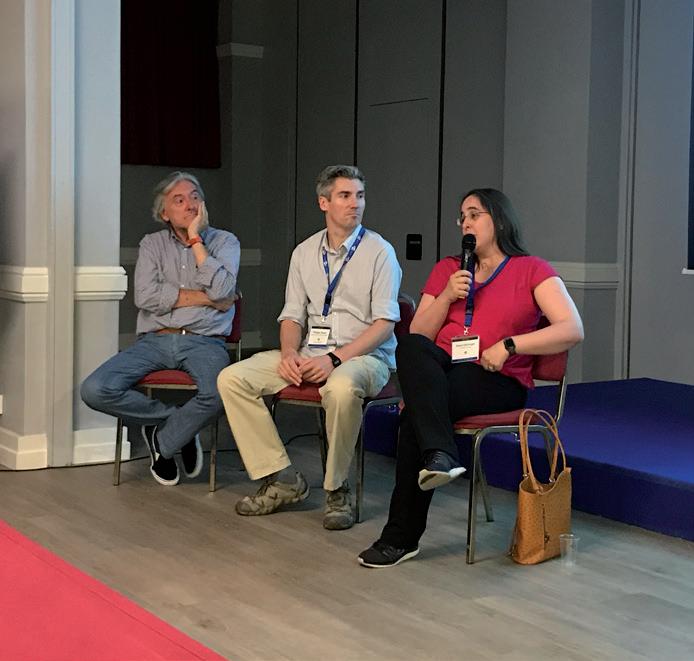

Available to PhD students and junior postdocs, HiPEAC collaboration grants support a three-month research stay at another institution within the HiPEAC network. In this article, Iván Fernández Vega (University of Malaga) explains how his collaboration with Onur Mutlu’s group at ETH Zürich led to a paper submission to a top computer architecture venue.
Breaking new boundaries through international exchange: HiPEAC collaboration grants
Accelerating time-series analysis with a memory-based accelerator
NAME: Iván Fernández Vega ROLE: PhD Student UNIVERSITY: University of Malaga
HOST INSTITUTION: ETH Zürich HOST SUPERVISOR: Onur Mutlu COLLABORATION DATES: 30.08.2021-29.11.2021
Having previously spent several months as a visitor at ETH Zürich, I was keen to return to the team and carry out further work. Thanks to my HiPEAC collaboration grant, I was able to spend three months in Onur Mutlu’s research group, focusing on memory-centric computing.
As Professor Mutlu has outlined (see for example HiPEACinfo 55), data movement within computing systems is a huge drain on energy use. During my research stay, my main objective was to study how dynamic time warping (DTW), a time-series analysis algorithm, could be sped up using an accelerator based on nonvolatile memories. These TSA algorithms are usually memory bound, so reducing the impact of data movement is crucial.
Using the processing-using-memory (PUM) approach, we aimed to reduce the impact of data movement in terms of energy consumption, while simultaneously improving performance by carrying out the computation where the data resides. Did you know? As reported in HIPEACinfo 63, in 2021 UPMEM announced that it was the first company to mass produce a general-purpose accelerator based on processing in memory, a breakthrough awaited by the computing industry for nearly two decades. UPMEM, a startup incorporated in 2015, is based in Grenoble, France.
Developing a memristor accelerator
Second, we started to develop the idea of building the accelerator. We wanted to evaluate how memristor-based crossbars can perform in-situ computation, enabling a faster, more energyefficent computation of state-of-the-art TSA algorithms. MATSA, which stands for MRAM-based Acclerator for Time Series Analaysis, uses SOT-MRAM crossbars to perform the computation in situ. I developed the analytical model to evaluate performance and energy use, and we are currently working on getting the results and comparing them to the baselines.
Did you know? MRAM refers to magnetoresistive random access memory, a type of non-voltatile memory which stores data in magnetic domains, while SOT refers to spin-orbit torque, a technology to manipulate magnetization through electric currents.
Implementing the algorithm using UPMEM
First, we started to characterize the algorithm. To do so, I developed baselines on commodity processors – central and graphics processing units (CPUs and GPUs) – along with a fieldprogrammable gate array (FPGA) implementation based on high-level synthesis. Next, I developed an implementation of the algorithm using UPMEM, a commercially available processing-inmemory architecture where small general-purpose processors are placed very close to the memory array. As a side project, I contributed to the evaluation of the SpMV kernel on the UPMEM architecture.
Professor Onur Mutlu commented: ‘The collaboration with Iván was extremely productive and helped us advance the state of the art in processing-in-memory and algorithm-architecture co-design. As a result of this work, we submitted a strong technical paper to a top venue in computer architecture, and will continue collaborating on non-volatile memories and processing in memory.’
HiPEAC internships are a great way to get work experience at a deep tech company. Beyond that, they can even be life changing, sometimes leading to a job offer, as Maria Oikonomidou found out.
HiPEAC internships: Your career starts here
Data-driven decision making at inbestMe
NAME: Maria Oikonomidou RESEARCH CENTRE: Foundation for Research and Technology Hellas (FORTH) and University of Crete
HOST COMPANY: inbestMe DATE OF INTERNSHIP: 15.06.2021 - 15.09.2021
As a graduate assistant at the Institute of Computer Science, FORTH, my studies centred on parallel and distributed systems, algorithms and systems analysis. I was particularly drawn to data science, graphs and applied machine learning for large complex networks, as well as parallel and distributed computing. I’d had experience of addressing problems on social media, particularly on Twitter and YouTube, and found that I was really passionate about finding motifs in individuals’ digital footprints and using them to understand behaviours.
The internship opportunity at inbestMe was therefore an ideal fit for me. A roboadvisor which offers tailored investment plans for its clients, inbestMe uses technology to automate as much as possible, which helps keep costs down and consequently offer better returns. My role was to gain as many insights as possible from data to help improve the customer experience.
During my internship, I analysed inbestMe’s website traffic, seeking answers to questions about the source of the traffic – including which marketing campaigns had brought visitors to the website – as well as users’ behaviour on the site, such as how long they spent on each page and how they navigated the site. I also helped develop a tool to help predict potential future clients: using machine learning techniques and by analysing existing customer behaviour, this tool is able to distinguish which of those users who sign up to the company are more likely to become clients.
Thanks to the HiPEAC internship, I got to know the team at inbestMe and show them what I can do. I’m happy to say that, once it was complete, inbestMe offered me a full-time role as their data scientist, allowing me to concentrate fully on providing enhanced data-driven decision making for the business by building out scalable data infrastructure.
Ferad Zyulkyarov, inbestMe’s chief technology officer, commented: ‘When I was a PhD student, HiPEAC helped me to develop in my career by offering range of opportunities to collaborate with industry and academia. Now, it still helps us by allowing us to reach to some of the best talent in Europe. For example, through the HiPEAC internship programme, we were able to find, train and then hire Maria. Besides benefiting from HiPEAC, I am very happy that we can also contribute and give back to the HiPEAC community by mentoring the students in applying their skills and expertise in solving real-life business problems.
FURTHER INFORMATION: inbestMe website inbestme.com


The HiPEAC network includes almost 1,000 PhD students, representing the next generation of computing systems experts. Last year, Fabian Schuiki was one of those students; today, he is a senior compiler engineer at SiFive. In this article, we find out about Fabian’s thesis on energy-efficient architectures for high-performance computing.
Three-minute thesis
Featured research: Breaking the von Neumann bottleneck for energy-efficient HPC
NAME: Fabian Schuiki
RESEARCH CENTRE: ETH Zürich SUPERVISOR: Luca Benini THESIS TITLE: Streaming Architectures for Extreme Energy Efficiency in HighPerformance Computing
As the HiPEAC community is well aware, the end of Moore’s Law and the breakdown of Dennard scaling in silicon manufacturing has prompted a paradigm shift in the way we approach computer architecture design. Now that increased performance cannot be achieved through advanced manufacturing processes alone, research is increasingly focused on developing technology-aware computer architectures.
Energy efficiency is a critical focus, as a significant proportion of the physical limitations we see on today’s high-performance computing (HPC) systems stem from heat dissipation. Hence performance at low power is the key to achieving high utilization of the available hardware, in order to mitigate the effects of limited frequency and overcome dark silicon.
The von Neumann bottleneck, in which instruction fetches compete with data accesses for memory bandwidth, is one of the key challenges in this area. This bottleneck also applies to the instruction pipeline of a processor, where load-store and control instructions compete with compute instructions for issue slots.
Specialist vs generalist
A popular way to overcome this bottleneck is to implement dedicated accelerators for a specific problem, an approach which has gained popularity with the rise of machine learning. This is based on the observation that, all other things being equal, specialization in hardware always wins. However, the lack of general programmability limits the accelerator’s use to a specific problem. At a time of fast-moving algorithms, today’s hardware accelerators will be unable to compute tomorrow’s algorithms. In parallel, general-purpose processors have also evolved to mitigate the von Neumann bottleneck, for example in the complex to reduced instruction set (CISC-to-RISC) translation in modern processors, which can act as an instruction compression scheme. Similarly, single-instruction, multiple-data (SIMD) and single-instruction, multiple-thread (SIMT) paradigms offer a fixed increase in computations per second, while Cray-style vectorization offers a more dynamic and potentially higher increase.
Data-oblivious algorithms lend themselves particularly well to these kinds of acceleration. Including many algorithms from the fields of linear algebra, machine learning and scientific computing, in the case of these algorithms control flow decisions do not depend on the data it processes.
This thesis develops the concept of hardware address generation and direct memory streaming as a method to mitigate the von Neumann bottleneck. It then applies the concept to in-order, single-issue processors, allowing them to achieve full utilization of compute resources. Next, it introduces pseudo-dual-issue execution with dedicated compute hardware loops, and distils these extensions into an architectural template for highperformance computers capable of concentrating a significant part of its energy footprint in the arithmetic units.
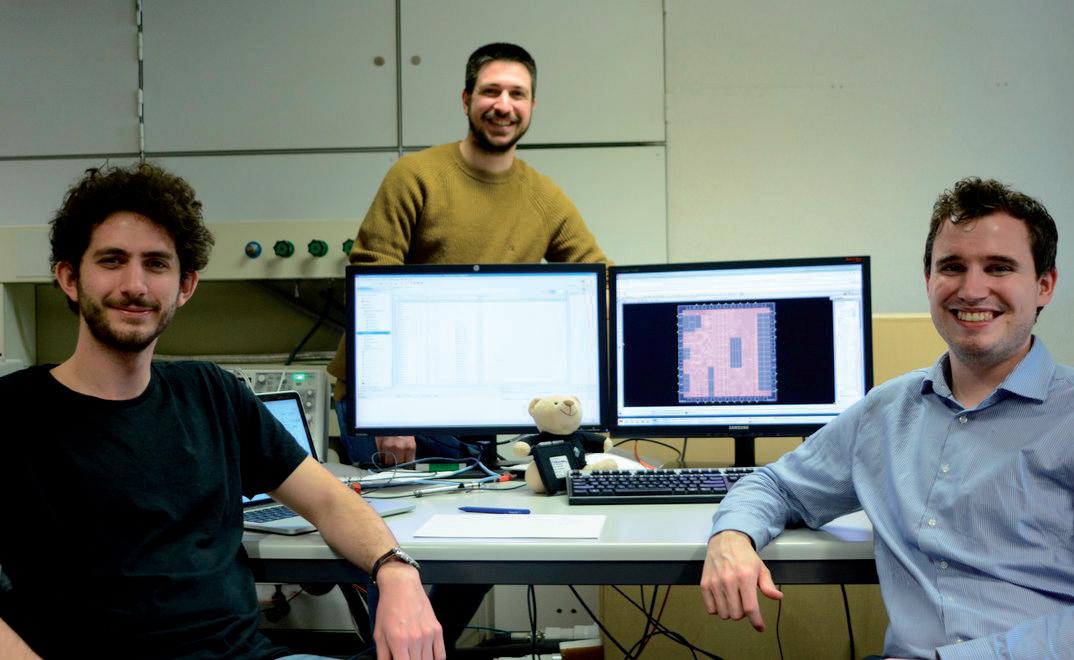
Fabian (right) and colleagues in the lab

